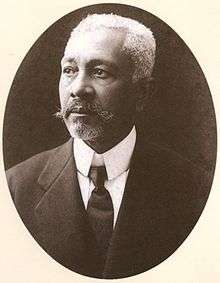Teodoro Fernandes Sampaio
Teodoro Fernandes Sampaio (Portuguese pronunciation: [teoˈdɔru feʁˈnɐ̃dʒis sɐ̃ˈpaju]) (7 January 1855 - 11 October 1937) was an Afro-Brazilian polymath and public intellectual who worked as an engineer, geographer, politician, and historian.[1]

Early life
Sampaio was born on the Engenho Canabrava, property of the Visconde de Aramaré in Santo Amaro, Bahia. His father was Manuel Fernandes Sampaio, a white priest, and his mother, Domingas da Paixão do Carmo, was an enslaved woman.
Education
In 1864 his father took young Sampaio to São Paulo and Rio de Janeiro, where he studied engineering at the Colégio Central.
During his studies in Rio de Janeiro, Sampaio worked as a drafter and taught mathematics in the Museu Nacional.[2]
Sampaio graduated with a degree in civil engineering from the Polytechnic School in Rio de Janeiro in 1877 and returned to Santo Amaro. Reunited with mother, Sampaio managed to purchase the manumission of his three brothers Martinho, Ezequiel, e Matias.[3]
Engineering and cartography
In 1879, Emperor Pedro II of Brazil named Sampaio to the national "Comissão Hidráulica" (Hydraulic Commission). He was the only Brazilian serving on a team of U.S. engineers working to enlarge the port of Santos[4] led by William Milnor Roberts.[5] As part of this endeavour, Sampaio produced his first cartographic work, drawing the blueprints and survey charts of the port of Santos along with surveys of the São Francisco river. The expedition explored the river from its mouth, on the Atlantic Ocean, up to the navigable limit at the time, near the town of Pirapora in the then province of Minas Gerais.[5] The return journey, inland through the north-eastern Brazilian state of Bahia, led to Sampaio's major cartographic work, the topographic survey of Chapada Diamantina, a mountain range in Bahia State, and his book O rio São Francisco e a Chapada Diamantina,[6] published in 1906, which later became a classic of Brazil's history and geography.
Institutional memberships
Sampaio was one of the founders of the Escola Politécnica of São Paulo (Polytechnic School of São Paulo) in 1893 and of the Instituto Histórico e Geográfico de São Paulo (Historical and Geographical Institute of São Paulo) in 1894. He was also a member of the Instituto Geográfico e Histórico da Bahia, serving as president in 1922, and a member of the Instituto Histórico e Geográfico Brasileiro (1902).
Historical significance
Sampaio was the first person with an enslaved mother to become a federal deputy in Brazil's history.
His most important books were:
- O rio São Francisco e a Chapada Diamantina (1906)
- O Tupi na geografia nacional (1901)
- Atlas dos Estados Unidos do Brasil (1908)
- Dicionário histórico, geográfico e etnográfico do Brasil (1922)
- História da Fundação da Cidade do Salvador (póstumo).
Books about him:
- Theodoro Sampaio e a Chapada Diamantina (Trechos da expedição de 1879/1880), Otoniel Fernandes Neto, ed. do Author, Brasília, 2005. (ISBN 85-905834-1-4).
- Baianos Ilustres, Antônio Loureiro de Souza, Salvador, 1949.
A well-known, major street in the city of São Paulo, Rua Teodoro Sampaio, is dedicated to Sampaio.[7]
Bibliography
- "Theodoro Sampaio - nos sertões e nas cidades" Versal Editores, Rio de Janeiro, 2010. (ISBN 978-85-89309-26-4).
- O Rio São Francisco e a Chapada Diamantina, Teodoro Sampaio (José Carlos Barreto de Santana org.), Companhia das Letras, São Paulo, 2002. (ISBN 85-359-0256-2)
- Theodoro Sampaio e a Chapada Diamantina (Trechos da expedição de 1879/1880), Otoniel Fernandes Neto, ed. do Autor, Brasília, 2005. (ISBN 85-905834-1-4).
- Baianos Ilustres, Antônio Loureiro de Souza, Salvador, 1949.
References
- Schwarcz, Lilia Moritz (22 January 2011). "Theodoro Sampaio ajudou a integrar o país". Folha de S.Paulo Ilustrada. Retrieved 6 October 2014.
- Monteiro, Filipe (10 March 2008). "Revista de História". Retrieved 6 October 2014.
- Albuquerque, Wlamyra; Albuquerque, Wlamyra (June 2015). "Teodoro Sampaio e Rui Barbosa no tabuleiro da política: estratégias e alianças de homens de cor (1880-1919)". Revista Brasileira de História (in Portuguese). 35 (69): 83–99. doi:10.1590/1806-93472015v35n69005. ISSN 0102-0188.
- Garcez, Lucas Norgueira (Abril–Junho 1958). "Teodoro Sampaio (Engenheiro)". Revista do Instituto Histórico e Geográfico Brasileiro (239): 152–160. Check date values in:
|date=(help) - Santos, Ademir Pereira dos; Carlos, Rosa Matilde Pimpão (2017-06-26). "Theodoro Sampaio e a primeira base geodésica do Brasil". Terra Brasilis (Nova Série). Revista da Rede Brasileira de História da Geografia e Geografia Histórica (in Portuguese) (8). doi:10.4000/terrabrasilis.2230. ISSN 1519-1265.
- Sampaio, Teodoro, 1855-1937. (2002). O rio São Francisco e a Chapada Diamantina. Santana, José Carlos Barreto de, 1966-, Sampaio, Teodoro, 1855-1937. [São Paulo, Brazil]: Companhia das Letras. ISBN 85-359-0256-2. OCLC 50552388.CS1 maint: multiple names: authors list (link)
- "Long Term Exhibition". Afro Brasil Museum. Retrieved 14 June 2020.
External links
- Works by Teodoro Fernandes Sampaio at Faded Page (Canada)
- https://archive.is/20140119174546/http://biblio.etnolinguistica.org/autor ("Works by Teodoro Sampaio")
- http://mundoafro.atarde.com.br ("Reproduction of drawings by Teodoro Sampaio")